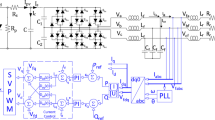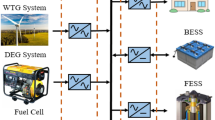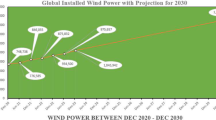Abstract
The interconnected power system is exposed to a wide range of disturbances that may induce electromechanical oscillations of small magnitude and often persist for long periods. Such oscillations may sustain and grow, causing system separation if no adequate damping is provided. Conventional Power System Stabilizers (PSSs) are often used to provide the necessary damping torque to suppress the oscillation through the excitation system. The design of PSS in the previous work is either nonlinear or entirely linear based on a linearized model around an equilibrium point. Nonlinear controllers provide very robust performance. However, their complexity limits their deployment. On the other hand, linear-based PSSs are simple, but their performance degrades as the operating conditions move away from the region of attraction. Unlike previously published work, the design of the PSS in this paper explicitly uses the nonlinear model of the power system and linear control theory. This paper presents a nonlinear PSS based on feedback linearization. The Riccati equation is used to construct the new coordinate’s linear controller. The efficacy of the presented study is demonstrated through a comparison with nonlinear-based and linear-based PSSs. Performing an in-depth analysis of inertia’s impact on the system’s stability concludes the proposed study.











Similar content being viewed by others
Abbreviations
- \({\varvec{E}}_{{{\varvec{FD}}}}\) :
-
Field voltage
- \({\varvec{E}}_{{\varvec{q}}}^{\user2{^{\prime}}}\) :
-
Quadrature internal voltage
- \({\varvec{K}}_{{\varvec{A}}}\) :
-
Exciter gain
- \({\varvec{i}}_{{\varvec{d}}}\) :
-
Direct axis current [A]
- \({\varvec{i}}_{{\varvec{q}}}\) :
-
Quadrature axis current
- \({\varvec{K}}_{{\varvec{i}}}\) :
-
Linearizing constants \(\forall \user2{ i } = \user2{ }\left\{ {1 - 6} \right\}\)
- \({\varvec{P}}_{{\varvec{e}}}\) :
-
Electrical power in [MW]
- \({\varvec{P}}_{{\varvec{m}}}\) :
-
Mechanical power [MW]
- \({\varvec{T}}_{{\varvec{A}}}\) :
-
Exciter time constant
- \({\varvec{T}}_{{{\varvec{do}}}}^{\user2{^{\prime}}}\) :
-
Transient time constant [s]
- \({\varvec{T}}_{{\varvec{e}}}\) :
-
Electrical torque [N/m]
- \({\varvec{T}}_{{\varvec{j}}}\) :
-
Time constants \(\forall {\varvec{j}} = \user2{ }\left\{ {1 - 4} \right\}\)
- \({\varvec{U}}_{{{\varvec{pss}}}}\) :
-
Power system stabilizer signal
- \({\varvec{V}}_{{\varvec{R}}}\) :
-
Regulated voltage [Volt]
- \({\varvec{V}}_{{{\varvec{ref}}}}\) :
-
Reference voltage
- \({\varvec{V}}_{{\varvec{t}}}\) :
-
Terminal voltage
- \({\varvec{v}}_{{\varvec{d}}}\) :
-
Direct axis voltage
- \({\varvec{v}}_{{\varvec{q}}}\) :
-
Quadrature voltage
- \({\varvec{w}}_{{\varvec{s}}}\) :
-
Synchronous speed [Rad/Sec]
- \(\dot{\user2{x}}\) :
-
System dynamics \(\forall \user2{ \dot{x} } \in {\mathbb{R}}^{{\varvec{n}}}\)
- \({\varvec{x}}_{{\varvec{d}}}\) :
-
Direct axis reactance
- \({\varvec{x}}_{{\varvec{d}}}^{\user2{^{\prime}}}\) :
-
Transient reactance of the machine
- \(\dot{\user2{z}}\) :
-
Dynamics in the new coordinate \(\forall \user2{ \dot{z} } \in {\mathbb{R}}^{{\varvec{n}}}\)
- \({\varvec{\delta}}\) :
-
Angular displacement of the rotor [Elec Rad /Sec]
- \({\varvec{\omega}}\) :
-
Actual rotor speed [rad/s]
- \(\phi\) :
-
Suggested manifold
- \({\varvec{\zeta}}\) :
-
Damping ratio
- \({\varvec{\omega}}_{{\varvec{n}}}\) :
-
Undamped frequency [rad/s]
- \({\varvec{\omega}}_{{\varvec{d}}}\) :
-
Damped frequency [rad/s]
References
Kundur, P.: Power System Stability and Control. McGraw-Hill Education (1994)
Marić, P.; Kljajić, R.; Chamorro, H.R.; Glavaš, H.: Power system stabilizer tuning algorithm in a multimachine system based on s-domain and time domain system performance measures. Energies (2021). https://doi.org/10.3390/en14185644
Abd Elazim, S.M.; Ali, E.S.: Optimal power system stabilizers design via cuckoo search algorithm. Int. J. Electr. Power Energy Syst. 75, 99–107 (2016). https://doi.org/10.1016/j.ijepes.2015.08.018
Hemmati, R.: Power system stabilizer design based on optimal model reference adaptive system. Ain Shams Eng. J. 9(2), 311–318 (2018). https://doi.org/10.1016/j.asej.2016.03.002
Allaboyena, G. K., Yilmaz, M.: Robust power system stabilizer modeling and controller synthesis framework. In: 2019 IEEE International Conference on Electro Information Technology (EIT), May 2019, pp. 207–212. https://doi.org/10.1109/EIT.2019.8833656.
Singh, M.; Patel, R.N.; Neema, D.D.: Robust tuning of excitation controller for stability enhancement using multi-objective metaheuristic Firefly algorithm. Swarm Evol. Comput. 44, 136–147 (2019). https://doi.org/10.1016/j.swevo.2018.01.010
Abido, M.A.: Robust design of multimachine power system stabilizers using simulated annealing. IEEE Trans. Energy Convers. 15(3), 297–304 (2000). https://doi.org/10.1109/60.875496
Butti, D.; Mangipudi, S.K.; Rayapudi, S.R.: An improved whale optimization algorithm for the design of multi-machine power system stabilizer. Int. Trans. Electr. Energy Syst. 30(5), e12314 (2020). https://doi.org/10.1002/2050-7038.12314
Dasu, B.; Mangipudi, S.; Rayapudi, S.: Small signal stability enhancement of a large scale power system using a bio-inspired whale optimization algorithm. Prot. Control Mod. Power Syst. 6(1), 35 (2021). https://doi.org/10.1186/s41601-021-00215-w
Butti, D.; Mangipudi, S.K.; Rayapudi, S.: Model order reduction based power system stabilizer design using improved whale optimization algorithm. IETE J. Res. (2021). https://doi.org/10.1080/03772063.2021.1886875
Ali, E.S.: Optimization of power system stabilizers using BAT search algorithm. Int. J. Electr. Power Energy Syst. 61, 683–690 (2014). https://doi.org/10.1016/j.ijepes.2014.04.007
Abd-Elazim, S.M.; Ali, E.S.: Power system stability enhancement via bacteria foraging optimization algorithm. Arab. J. Sci. Eng. 3(38), 599–611 (2013). https://doi.org/10.1007/s13369-012-0423-y
Costa Filho, R.N.D.; Paucar, V.L.: A multi-objective optimization model for robust tuning of wide-area PSSs for enhancement and control of power system angular stability. Results Control Optim. 3, 100011 (2021). https://doi.org/10.1016/j.rico.2021.100011
Li, M.; Chen, Y.: Designing of power system stabilizer based on neural-like P systems. Proc. Inst. Mech. Eng. Part J. Syst. Control Eng. 234(2), 199–210 (2020). https://doi.org/10.1177/0959651819851668
Chaib, L.; Choucha, A.; Arif, S.; Zaini, H.G.; El-Fergany, A.; Ghoneim, S.S.M.: Robust design of power system stabilizers using improved harris hawk optimizer for interconnected power system. Sustainability (2021). https://doi.org/10.3390/su132111776
Kolesnikov, A.A.: The basis of the synergetic control theory. Ispo-Serv. (2002)
Kolesnikov, A.A.: Synergetic control theory. Energoatomizdat (1994)
Jiang, Z.: Design of a nonlinear power system stabilizer using synergetic control theory. Electr. Power Syst. Res. 79(6), 855–862 (2009). https://doi.org/10.1016/j.epsr.2008.11.006
Farahani, M.; Ganjefar, S.: Intelligent power system stabilizer design using adaptive fuzzy sliding mode controller. Neurocomputing 226, 135–144 (2017). https://doi.org/10.1016/j.neucom.2016.11.043
Tare, Arti. V., Jadhav, S. S., Pande, V. N., Ghanegaonkar, S. P.: Design of Power System Stabilizer as Second-Order Sliding Mode Controller. In: Smart Sensors Measurements and Instrumentation, pp. 295–305 Singapore, New York (2021). https://doi.org/10.1007/978-981-16-0336-5_24.
Verrelli, C.M.; Marino, R.; Tomei, P.; Damm, G.: Nonlinear robust coordinated PSS-AVR control for a synchronous generator connected to an infinite bus. IEEE Trans. Autom. Control. (2021). https://doi.org/10.1109/TAC.2021.3062174
Lu, Q.; Sun, Y.; Mei, S.: Nonlinear control systems and power system dynamics. Springer, US, Boston, MA (2001) https://doi.org/10.1007/978-1-4757-3312-9
Chernous’ko, F.L.; Ananievski, I.M.; Reshmin, S.A.: Control of nonlinear dynamical systems: methods and applications. Springer-Verlag, Berlin Heidelberg (2008) https://doi.org/10.1007/978-3-540-70784-4
Kolesnikov, A. A.: Introduction of synergetic control. In: 2014 American Control Conference, Jun. 2014, pp. 3013–3016. https://doi.org/10.1109/ACC.2014.6859397.
Bezuglov, A.: Synergetic control theory approach for solving systems of nonlinear equations (2005)
Bhattacharya, S.: Power system oscillation damping by intelligent power system stabilizer. In: 2016 IEEE 1st International Conference on Power Electronics, Intelligent Control and Energy Systems (ICPEICES), Jul. 2016, pp. 1–6. https://doi.org/10.1109/ICPEICES.2016.7853509.
Sreedivya, K. M., Jeyanthy, P. A., Devaraj, D.: Fuzzy logic based power system stabilizer for damping low frequency oscillations in power system. In: 2017 International Conference on Innovations in Electrical, Electronics, Instrumentation and Media Technology (ICEEIMT), Feb. 2017, pp. 201–205. https://doi.org/10.1109/ICIEEIMT.2017.8116835.
El-Metwally, K.A.; Hancock, G.C.; Malik, O.P.: Implementation of a fuzzy logic PSS using a micro-controller and experimental test results. IEEE Trans. Energy Convers. 11(1), 91–96 (1996). https://doi.org/10.1109/60.486581
Liu, W.; Venayagamoorthy, G.K.; Wunsch, D.C.: Design of an adaptive neural network based power system stabilizer. Neural Netw. 16(5), 891–898 (2003). https://doi.org/10.1016/S0893-6080(03)00129-1
Liao, K.; He, Z.; Xu, Y.; Chen, G.; Dong, Z.Y.; Wong, K.P.: A sliding mode based damping control of DFIG for interarea power oscillations. IEEE Trans. Sustain. Energy 8(1), 258–267 (2017). https://doi.org/10.1109/TSTE.2016.2597306
Lee, S.-S., Li, S.-Y., Park, J.-K.: Nonlinear back-stepping controller design for the enhancement of transient stability in power systems. In: 2007 American Control Conference, Jul. 2007, pp. 5905–5910. https://doi.org/10.1109/ACC.2007.4282320.
Safie, S. I., Shah, M., Hasimah, A. R., Wahab, A., Yusri, H. M.: Sliding mode control power system stabilizer (PSS) for Single Machine Connected to Infinite Bus (SMIB). In: 2008 IEEE 2nd International Power and Energy Conference, Dec. 2008, pp. 122–126. https://doi.org/10.1109/PECON.2008.4762447.
Abido, M.A.: Optimal design of power-system stabilizers using particle swarm optimization. IEEE Trans. Energy Convers. 17(3), 406–413 (2002). https://doi.org/10.1109/TEC.2002.801992
Yasaei, Y., Karimi-Ghartemani, M., Bakhshai, A., Parniani, M.: Design of a nonlinear power system stabilizer. In: 2010 IEEE International Symposium on Industrial Electronics, Jul. 2010, pp. 143–147. https://doi.org/10.1109/ISIE.2010.5637607.
Alotaibi, I.M.; Abido, M.A.; Khalid, M.: Primary frequency regulation by demand side response. Arab. J. Sci. Eng. (2021). https://doi.org/10.1007/s13369-021-05440-x
Acknowledgements
The authors would like to acknowledge the support provided by King Fahd University of Petroleum Minerals through Direct Fund project # DF201022. Mr. Alotaibi also acknowledges Electrical Engineering Department, Qassim University, Qassim 51411, Saudi Arabia. Dr. Abido also acknowledges the support provided by KACARE Energy Research & Innovation Center (ERIC), KFUPM.
Author information
Authors and Affiliations
Corresponding author
Appendices
Appendix
System Parameters
See Table
2.
Lie Derivative
where \({\mathcal{L}}_{{i^{\prime}s}}\) are defined as follows:
Rights and permissions
About this article
Cite this article
Alotaibi, I.M., Ibrir, S., Abido, M.A. et al. Nonlinear Power System Stabilizer Design for Small Signal Stability Enhancement. Arab J Sci Eng 47, 13893–13905 (2022). https://doi.org/10.1007/s13369-022-06566-2
Received:
Accepted:
Published:
Issue Date:
DOI: https://doi.org/10.1007/s13369-022-06566-2




